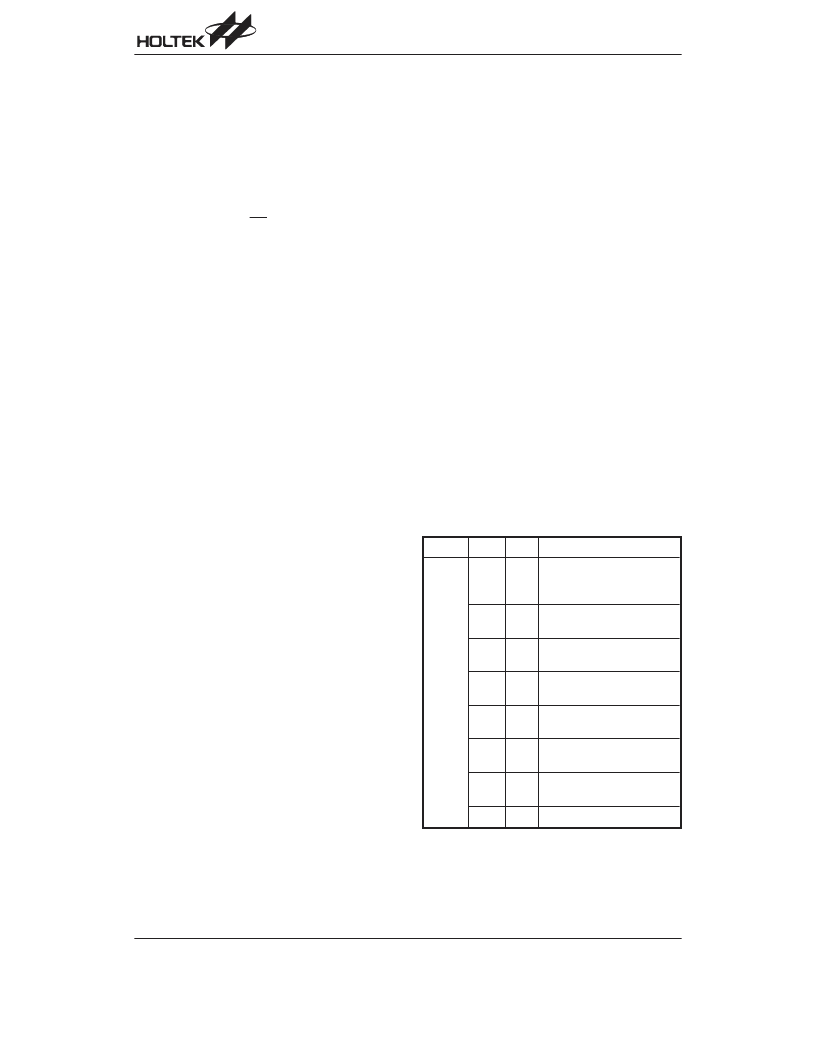- 您現(xiàn)在的位置:買賣IC網(wǎng) > PDF目錄385405 > HT86576 (Holtek Semiconductor Inc.) Voice Synthesizer 8-Bit MCU PDF資料下載
參數(shù)資料
| 型號: | HT86576 |
| 廠商: | Holtek Semiconductor Inc. |
| 英文描述: | Voice Synthesizer 8-Bit MCU |
| 中文描述: | 語音合成器8位微控制器 |
| 文件頁數(shù): | 22/39頁 |
| 文件大小: | 368K |
| 代理商: | HT86576 |
第1頁第2頁第3頁第4頁第5頁第6頁第7頁第8頁第9頁第10頁第11頁第12頁第13頁第14頁第15頁第16頁第17頁第18頁第19頁第20頁第21頁當(dāng)前第22頁第23頁第24頁第25頁第26頁第27頁第28頁第29頁第30頁第31頁第32頁第33頁第34頁第35頁第36頁第37頁第38頁第39頁

HT86XXX
Rev. 1.70
22
May 6, 2004
As an interrupt is serviced, a control transfer occurs by
pushing the program counter onto the stack and then
branching to subroutines at the specified location(s) in
the program memory. Only the program counter is
pushed onto the stack. The programmer must save the
contents of the register or status register (STATUS) in
advance if they are altered by an interrupt service pro-
gram which corrupts the desired control sequence.
External interrupt is triggered by a high-to-low/
low-to-high transition of INT pin which sets the related
interrupt request flag (EIF:bit 4 of INTC). When the inter-
rupt is enabled, and the stack is not full and the external
interrupt is active, a subroutine call to location 04H will
occur. The interrupt request flag (EIF) and EMI bits will
be cleared to disable other interrupts.
The internal Timer/Event Counter 0 interrupt is initial-
ized by setting the Timer/Event counter 0 interrupt re-
quest flag (T0F:bit 5 of INTC), caused by a Timer/Event
Counter 0 overflow. When the interrupt is enabled, and
the stack is not full and the T0F bit is set, a subroutine
call to location 08H will occur. The related interrupt re-
quest flag (T0F) will be reset and the EMI bit cleared to
disable further interrupts.
The internal Timer/Event Counter 1 interrupt is initial-
ized by setting the Timer/Event Counter 1 interrupt re-
quest flag (T1F:bit 6 of INTC), caused by a Timer/Event
Counter 1 overflow. When the interrupt is enabled, and
the stack is not full and the T1F bit is set, a subroutine
call to location 0CH will occur. The related interrupt re-
quest flag (T1F) will be reset and the EMI bit cleared to
disable further interrupts.
The internal Timer Counter 2 interrupt is initialized by
setting the Timer Counter 2 interrupt request flag
(T2F:bit 0 of INTCH), caused by a Timer Counter 2 over-
flow. When the interrupt is enabled, and the stack is not
full and the T2F bit is set, a subroutine call to location
10H will occur. The related interrupt request flag (T2F)
will be reset and the EMI bit cleared to disable further in-
terrupts.
The internal Timer Counter 3 interrupt is initialized by
setting the Timer Counter 3 interrupt request flag
(T3F:bit 1 of INTCH), caused by a Timer Counter 3 over-
flow. When the interrupt is enabled, and the stack is not
full and the T3F bit is set, a subroutine call to location
14H will occur. The related interrupt request flag (T3F)
will be reset and the EMI bit cleared to disable further in-
terrupts.
During the execution of an interrupt subroutine, other in-
terrupt acknowledges are held until the RETI instruction
is executed or the EMI bit and the related interrupt con-
trol bit are set to 1 (of course, if the stack is not full). To
return from the interrupt subroutine, the RET or RETI in-
struction may be invoked. RETI will set the EMI bit to en-
able an interrupt service, but RET will not.
Interrupts occurring in the interval between the rising
edges of two consecutive T2 pulses, will be serviced on
the latter of the two T2 pulses, if the corresponding inter-
rupts are enabled. In the case of simultaneous requests,
the following table shows the priority that is applied.
These can be masked by resetting the EMI bit.
The Timer/Event Counter 0/1 interrupt request flag
(T0F/T1F) which enables Timer/Event Counter 0/1 con-
trol bit (ET0I/ET1I), the Timer Counter 2/3 interrupt re-
quest flag (T2F/T3F) which enables Timer Counter 2/3
control bit (ET2I/ET3I), and external interrupt request
flag (EIF) which enables external interrupt control bit
(EEI) form the interrupt control register (INTC:0BH and
INTCH:1EH). EMI, EEI, ET0I, ET1I, ET2I, and ET3I are
used to control the enabling/disabling of interrupts.
These bits prevent the requested interrupt begin ser-
viced. Once the interrupt request flags (T0F, T1F, T2F,
T3F, EIF) are set, they will remain in the INTC/INTCH
register until the interrupts are serviced or cleared by a
software instruction.
It is recommended that application programs do not use
CALL subroutines within an interrupt subroutine. Inter-
rupts often occur in an unpredictable manner or need to
be serviced immediately in some applications. If only
one stack is left and the interrupt enable is not well con-
trolled, once a CALL subroutine if used in the interrupt
subroutine will corrupt the original control sequence.
Register Bit No. Label
Function
INTC
(0BH)
0
EMI
Controls the master (global)
interrupt
(1= enabled; 0= disabled)
1
EEI
Controlstheexternalinterrupt
(1= enabled; 0= disabled)
2
ET0I
Controls the timer 0 interrupt
(1= enabled; 0= disabled)
3
ET1I
Controls the timer 1 interrupt
(1= enabled; 0= disabled)
4
EIF
Externalinterruptrequestflag
(1= active; 0= inactive)
5
T0F
Timer 0 request flag
(1= active; 0= inactive)
6
T1F
Timer 1 request flag
(1= active; 0= inactive)
7
Unused bit, read as 0
INTC0 Register
相關(guān)PDF資料 |
PDF描述 |
|---|---|
| HT86R192 | Voice Synthesizer 8-Bit OTP MCU |
| HT86R384 | Voice Synthesizer 8-Bit OTP MCU |
| HT86XXX | 8-Bit Voice Synthesizer MCU |
| HT8950 | Voice Modulator |
| HT8955 | Voice Echo |
相關(guān)代理商/技術(shù)參數(shù) |
參數(shù)描述 |
|---|---|
| HT8658 | 制造商:HOLTEK 制造商全稱:Holtek Semiconductor Inc 功能描述:Voice Recorder (DRAM) |
| HT8658A | 制造商:未知廠家 制造商全稱:未知廠家 功能描述:Solid-State Recorder |
| HT8658B | 制造商:未知廠家 制造商全稱:未知廠家 功能描述:Solid-State Recorder |
| HT8659 | 制造商:HOLTEK 制造商全稱:Holtek Semiconductor Inc 功能描述:Voice Recorder (DRAM) |
| HT8659A | 制造商:未知廠家 制造商全稱:未知廠家 功能描述:Solid-State Recorder |
發(fā)布緊急采購,3分鐘左右您將得到回復(fù)。